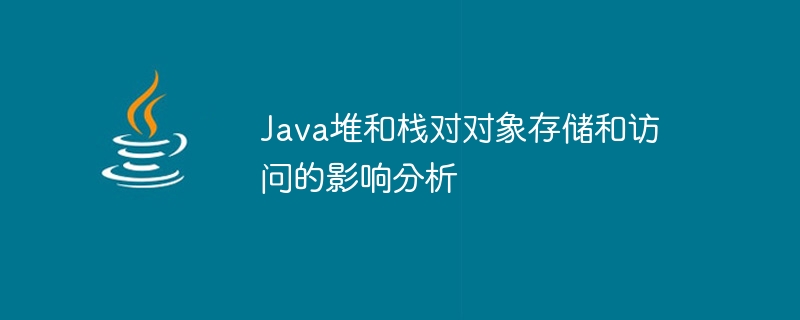

As an object-oriented programming language, Java has its own unique design and implementation of object storage and access methods. In Java, object storage and access involve the use of the Java heap and stack. This article will analyze the impact of Java heap and stack on object storage and access.
The Java heap is the largest memory area in the Java virtual machine and is used to store object instances and arrays. In the Java heap, the memory allocation of all object instances and arrays is dynamic. The size of the Java heap can be set through virtual machine startup parameters. Because the size of the Java heap is adjustable, the heap space may continue to expand and contract while the program is running.
The Java heap is characterized by the ability of automatic memory management, that is, the garbage collection mechanism. In Java, memory allocation and release are automatically performed by the virtual machine, which can effectively avoid memory leaks and memory overflow problems. When the object is no longer referenced, the garbage collection mechanism will automatically recycle it and release the memory. This automatic memory management mechanism reduces the burden on developers and makes program development more convenient.
Storing object instances and arrays in the Java heap has a certain impact on the storage and access of objects. First of all, because the size of the Java heap is adjustable, the storage and access of large objects will be more time-consuming. Large objects refer to objects that occupy a large amount of memory space. If the size of the Java heap is not large enough, it will need to be expanded frequently, resulting in reduced program running efficiency. Therefore, when designing a program, you should try to avoid using large objects, or set the size of the Java heap reasonably.
Secondly, when storing object instances and arrays in the Java heap, you need to consider the life cycle of the object. If an object has a long life cycle, it will occupy heap space for a long time. In this way, the burden of garbage collection will be increased, which may lead to frequent garbage collection operations, thereby affecting the performance of the program. Therefore, when designing a program, the life cycle of objects should be minimized and objects no longer used should be released in a timely manner.
In addition, the Java heap also has a certain impact on object access. In Java, objects are accessed through references. A reference is a pointer to an object through which the properties and methods of the object can be accessed. When storing object instances and arrays in the Java heap, they need to be accessed by reference. If the number of references is too large, it will increase the occupation of heap space and the cost of accessing objects. Therefore, when designing a program, unnecessary references should be minimized, excessive reference operations should be avoided, and the performance of the program should be improved.
In addition to the Java heap, the Java stack also affects the storage and access of objects. The Java stack is a last-in-first-out data structure used to save local variables, method parameters, and return values in methods. In the Java stack, object references and values of basic data types exist in the form of stack frames. Whenever a method is called, the Java virtual machine creates a stack frame and pushes it onto the stack. When the method is executed, the stack frame will be popped and the occupied memory will be released.
Storing object references and values of basic data types in the Java stack has a certain impact on the storage and access of objects. First of all, since the characteristic of the stack is last-in-first-out, the objects in the stack are temporary and only exist during the execution of the method. When the method is executed, the reference to the object will be released and the object instance will be garbage collected. Therefore, when using the Java stack to store objects, you need to pay attention to the life cycle of the object to avoid continuing to reference it after the method is executed.
Secondly, when storing object references in the Java stack, access to objects is faster. Because the stack is a continuous data structure, the reference of the object is stored in the stack frame and can be accessed directly. There is no need to look up the reference like the Java heap. Therefore, when you need to frequently access the properties and methods of an object, using object references in the stack can improve program performance.
To sum up, the Java heap and stack have a certain impact on object storage and access. When designing a program, you need to use the Java heap and stack reasonably, minimize the use of large objects, reduce the life cycle of objects, set the heap size reasonably, reduce unnecessary references, and improve program performance. Only by fully understanding and mastering the usage rules of Java heap and stack can we better store and access objects.
The above is the detailed content of Analyze the impact of Java heap and stack on object storage and access. For more information, please follow other related articles on the PHP Chinese website!




